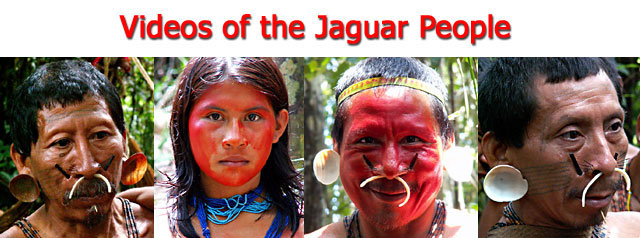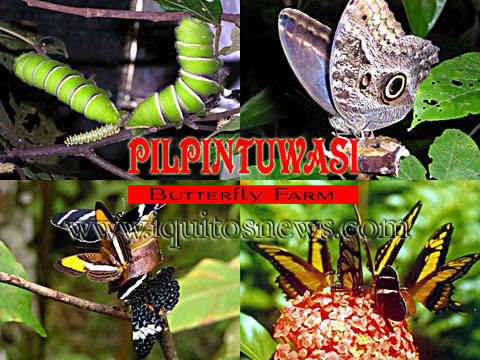t the entrance to the grounds of the Pilpintuwasi Butterfly Farm a
manguaré drum is sitting on the floor of a maloca, beside a sign which advises guests to beat the drum to call the tour guide then to relax in a hammock while they wait. The wait may be as entertaining as the farm itself, spiced up by the squawks of two macaws and two parrots which are pets of the owner, as well as the appearance of a number of wild monkeys, in the area for its number of large trees and safety from hunter’s rifles.
Accompanied by the owner Gudrun Sperrer, we entered the mesh covered butterfly house early in the morning, to see the new butterflies emerge from their cocoons. The word
Pilpintuwasi in the Quechua language means “butterfly’s home.” We passed first through the largest of those homes, following the meandering stone paths through an exotic and incredibly varied garden. Sperrer explained that they had selected each plant according to the needs of the insects. Each species of caterpillar and butterfly feeds on only one or two kinds of plants, she said. They had collected not only the caterpillars from the forest but also the plants on which they were feeding. The farm hosts 42 species of butterfly and the corresponding fruits, flowers and leaves on which they feed.
Some of the more remarkable of the species are the blue morph and the tattered winged buho, or owl butterfly, as well as some poison-haired caterpillars. The caterpillar of the brilliantly colored blue morpho pokes out two horn-like prongs from its head if it is threatened or when the guide taps it with a finger. The buho, so called for the large, dark spots on its impressive wings that resemble owl’s eyes, is one of the few aggressors on the farm. They pull at each other’s wings with barbed feet to defend their piece of fruit and consequently most have torn wings. They look like the butterflies in an old collector’s case. The smaller pavilion is a security measure against parasites. Every day eggs and cocoons are collected from the leaves and branches of the garden and stored in the smaller room. There Sperrer and others who help on the farm, disinfect the eggs with a light chlorine solution and dampen them periodically to simulate the rains that would moisten them if they were on a leaf in the forest. Some insects such as flies and mosquitoes lay eggs inside the butterfly eggs or inside the caterpillars. To limit the propagation if these parasites, Sperrer monitors the cocoons and eggs in the separate room, not allowing the flies that sometimes emerge from a cocoon to enter the butterfly farm.
Besides butterflies, visitors to the farm may see a young jaguar and a tapir, both of which Sperrer hesitantly adopted to spare them from a worse fate than the amply spaced cages on her property. They also breed a kind of large rodent particular to the Amazon called agouti, which, says Sperrer, “tastes like rabbit.”
Pilpintuwasi is located across the Nanay River near the village of Padre Cocha. From the port Bella Vista-Nanay it is about a 20 minute boat ride, and during the dry season the boats land at the village and visitors must walk along a forest path for about 15 minutes. It is open from Tuesday to Sunday, 9:00am to 5:00 pm. Entrance fees are (US) $5 for adults, $3 for students. The last guided tour of the day starts at 4:00 pm. Telephone: (094) 23 2665, cell: 932999, e-mail: pilpintuwasi@hotmail.com.
Be sure to visit their website at:
http://www.amazonanimalorphanage.com.

|


